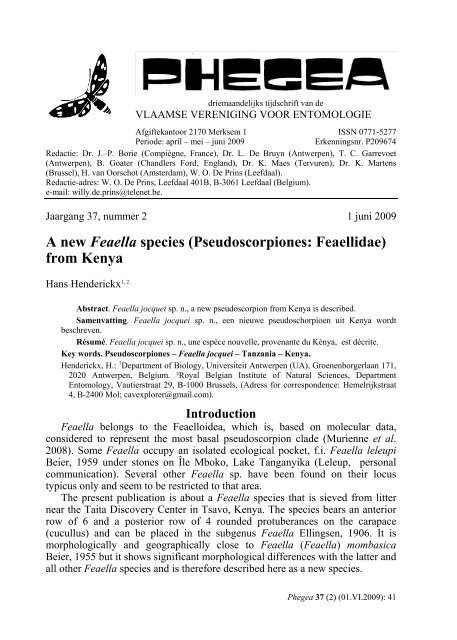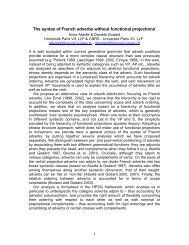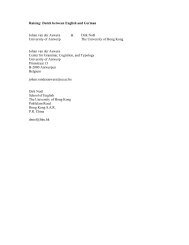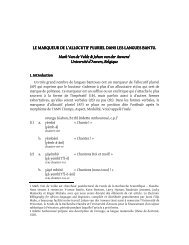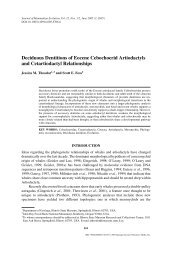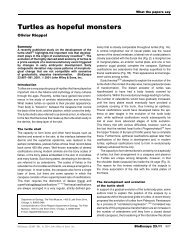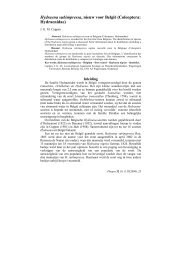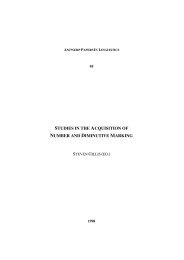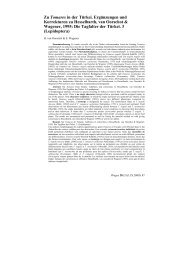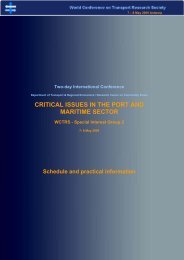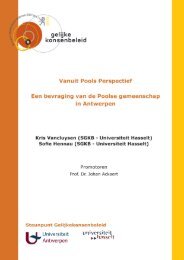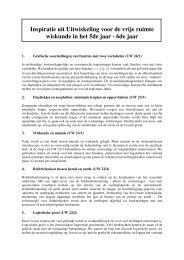A new Feaella species (Pseudoscorpiones: Feaellidae) from Kenya
A new Feaella species (Pseudoscorpiones: Feaellidae) from Kenya
A new Feaella species (Pseudoscorpiones: Feaellidae) from Kenya
You also want an ePaper? Increase the reach of your titles
YUMPU automatically turns print PDFs into web optimized ePapers that Google loves.
driemaandelijks tijdschrift van de<br />
VLAAMSE VERENIGING VOOR ENTOMOLOGIE<br />
Afgiftekantoor 2170 Merksem 1 ISSN 0771-5277<br />
Periode: april – mei – juni 2009<br />
Erkenningsnr. P209674<br />
Redactie: Dr. J.–P. Borie (Compiègne, France), Dr. L. De Bruyn (Antwerpen), T. C. Garrevoet<br />
(Antwerpen), B. Goater (Chandlers Ford, England), Dr. K. Maes (Tervuren), Dr. K. Martens<br />
(Brussel), H. van Oorschot (Amsterdam), W. O. De Prins (Leefdaal).<br />
Redactie-adres: W. O. De Prins, Leefdaal 401B, B-3061 Leefdaal (Belgium).<br />
e-mail: willy.de.prins@telenet.be.<br />
Jaargang 37, nummer 2 1 juni 2009<br />
A <strong>new</strong> <strong>Feaella</strong> <strong>species</strong> (<strong>Pseudoscorpiones</strong>: <strong>Feaellidae</strong>)<br />
<strong>from</strong> <strong>Kenya</strong><br />
Hans Henderickx 1, 2<br />
Abstract. <strong>Feaella</strong> jocquei sp. n., a <strong>new</strong> pseudoscorpion <strong>from</strong> <strong>Kenya</strong> is described.<br />
Samenvatting. <strong>Feaella</strong> jocquei sp. n., een nieuwe pseudoschorpioen uit <strong>Kenya</strong> wordt<br />
beschreven.<br />
Résumé. <strong>Feaella</strong> jocquei sp. n., une espèce nouvelle, provenante du Kénya, est décrite.<br />
Key words. <strong>Pseudoscorpiones</strong> – <strong>Feaella</strong> jocquei – Tanzania – <strong>Kenya</strong>.<br />
Henderickx, H.: 1 Department of Biology, Universiteit Antwerpen (UA), Groenenborgerlaan 171,<br />
2020 Antwerpen, Belgium. ²Royal Belgian Institute of Natural Sciences, Department<br />
Entomology, Vautierstraat 29, B-1000 Brussels, (Adress for correspondence: Hemelrijkstraat<br />
4, B-2400 Mol; cavexplorer@gmail.com).<br />
Introduction<br />
<strong>Feaella</strong> belongs to the Feaelloidea, which is, based on molecular data,<br />
considered to represent the most basal pseudoscorpion clade (Murienne et al.<br />
2008). Some <strong>Feaella</strong> occupy an isolated ecological pocket, f.i. <strong>Feaella</strong> leleupi<br />
Beier, 1959 under stones on Île Mboko, Lake Tanganyika (Leleup, personal<br />
communication). Several other <strong>Feaella</strong> sp. have been found on their locus<br />
typicus only and seem to be restricted to that area.<br />
The present publication is about a <strong>Feaella</strong> <strong>species</strong> that is sieved <strong>from</strong> litter<br />
near the Taita Discovery Center in Tsavo, <strong>Kenya</strong>. The <strong>species</strong> bears an anterior<br />
row of 6 and a posterior row of 4 rounded protuberances on the carapace<br />
(cucullus) and can be placed in the subgenus <strong>Feaella</strong> Ellingsen, 1906. It is<br />
morphologically and geographically close to <strong>Feaella</strong> (<strong>Feaella</strong>) mombasica<br />
Beier, 1955 but it shows significant morphological differences with the latter and<br />
all other <strong>Feaella</strong> <strong>species</strong> and is therefore described here as a <strong>new</strong> <strong>species</strong>.<br />
Phegea 37 (2) (01.VI.2009): 41
Material and methods<br />
A male and tritonymph (Fig. 3) of this <strong>species</strong> were collected by Jocqué and<br />
Warui (Royal Museum for Central Africa, Tervuren) by sieving litter, then<br />
transferred to ethanol 70%. Examination and measurements have been carried<br />
out with a Leitz microscope, electron microscopy with the FEI Quanta-200.<br />
Special attention was given to non-destructive examination techniques, no parts<br />
were removed <strong>from</strong> the holotype and the ESEM scanning microscopy was<br />
performed in low pressure water vapour.<br />
All measurements are in mm; (length=L × width=W), the ratio is the<br />
length/width index of an article.<br />
Systematics<br />
<strong>Feaella</strong> (<strong>Feaella</strong>) jocquei sp. n.<br />
(Figs. 1, 2)<br />
Type material: Male holotype and 1 tritonymph paratype, sample 209.608,<br />
Royal Museum for Central Africa, Tervuren. Information on label: <strong>Kenya</strong><br />
28.III.2000, loc. Tsavo, Taita Discovery Center, Eco. Acacia-Commiphora<br />
forest, Maungu near entrance gate, sieving litter, rec. Jocqué R. & Warui, C.,<br />
R.G. Mus. Afr. Centr. 209.608.<br />
Etymology: Patronym in honour of Rudy Jocqué, who collected the<br />
specimens.<br />
Diagnosis: A typical <strong>Feaella</strong> (<strong>Feaella</strong>) <strong>species</strong> with four equally sized, well<br />
developped eyes, the anterior part of the rear eye pair covered by carapacal<br />
cuticula (Fig. 2b). Second tergal plate completely split, pedipalpal trochanter<br />
with dorsal tubular projection. The <strong>new</strong> <strong>species</strong> is most closely related to <strong>Feaella</strong><br />
(<strong>Feaella</strong>) mombasica but differs <strong>from</strong> it by the split second tergal plate and the<br />
four equally sized eyes.<br />
Male holotype, description: (measurements in mm, ratio is L/W): Carapace<br />
longer than wide (1.42 ×), carapace and opisthosoma with a coarse reticulated<br />
texture forming ridges (fig. 2b). Both pairs of eyes well developped, equal in<br />
size. The anterior part of the second pair covered by carapace cuticula. Chelicera<br />
large, galea simple without rami, pointed. Movable finger with round terminal<br />
dimple and one seta, hand with 4 macrosetae. 6 microsetae near the edge of the<br />
dorsal, reticulated zone of the cheliceral hand. The proximal and ventral part of<br />
the chelicera lacks reticulation, that part is smooth as a hinge joint. Serrula of<br />
movable finger with 17 lobes, first lobe pointed.<br />
Tergal setae reduced, cannot be seen between the course reticulation. First<br />
tergite narrow, adapted to the flexible carapace-opisthosoma connection that is<br />
typical for <strong>Feaella</strong>. Tergites II to X distinct and completely split, XI th tergite<br />
ventrally joined with the terminal sternite, the circular anus is situated in this<br />
sclerite complex.<br />
Phegea 37 (2) (01.VI.2009): 42
First and second sternites fused, third sternite a narrow undivided strip<br />
bording the genital opening, extending laterally under the fourth coxa. Sternites<br />
IV to X completely divided. Pedipalpal coxa (Fig. 2d) with lateral thorn, near the<br />
joint with the leg coxa narrowed and in this zone without coarse granulation.<br />
The smooth surface there shows only a flat or honeycomb pattern, that might<br />
facilitate movement of the special joint connection. A honeycomb pattern is also<br />
visible on the part of the leg trochanter that moves in the leg coxa. (Fig. 2e).<br />
Pleurites with two rows of 15 plates.<br />
Pedipalp shape (Fig. 1a) typical <strong>Feaella</strong>, with a coarse reticulated structure.<br />
This reticulation lacks on the terminal part of the fingers and in the zone where<br />
the trichobothria are. Trochanter as long as broad, dorsally with a blunt 0.1 mm<br />
x 0.03 mm tubular projection. Femur 1.75× as long as broad, with a ridge that<br />
ends in a mediobasal thorn. Tibia 3× as long as broad, widening distally. Hand<br />
(without fingers) short, only slightly longer than broad (1.06×), complete chela<br />
(Fig. 1b) with pedicel 3,74× longer than broad. Both fingers internal with a large<br />
basal tooth (thorn). Several longitudinal rows of unequal teeth ending in a<br />
terminal teeth ‘crown’ of 5 teeth in both fingers. Fixed finger with an external<br />
row of 11 teeth, movable finger with a ventral row of 15 teeth.<br />
Fixed finger with 8, movable with 4 trichobothriae, positions illustrated on<br />
Fig. 1b. The internal trichobothriae on this external view are outlined with dots.<br />
Legs monotarate, a movable joint between telofemur and basifemur.<br />
Aroleum not longer than claws.<br />
Measurements (mm): Body length with chelicera 2.36, without chelicera<br />
2.20. Pedipalp: trochanter 0.16/0.16; femur 0.59/0.34; tibia 0.51/0.17; chela<br />
(with pedicel) 0.59/0.16; hand 0.17/0.16; movable finger L=0.42. Carapace<br />
0.71/0.45. Anterior and posterior eyes equal in size (diameter is 0.067).<br />
Leg I (Fig. 1c): trochanter 0.19/0.14; basifemur 0.24/0.08; telofemur<br />
0.28/0.10; tibia 0.21/0.08; tarsus 0.38/0.04.<br />
Leg IV (Fig. 1d): trochanter 0.37/0.17; basifemur 0.23/0.12; telofemur<br />
0.45/0.16; tibia 0.53/0.09; tarsus 0.57/0.05.<br />
Discussion<br />
Eight <strong>species</strong> and one sub<strong>species</strong> of <strong>Feaella</strong> are described <strong>from</strong> Africa. On<br />
base of the frontal carapacal lobes a further separation in three subgenera has<br />
been made: <strong>Feaella</strong> (Ellingsen , 1906), Tetrafeaella (Beier, 1955) and Difeaella.<br />
(Beier, 1966). <strong>Feaella</strong> jocquei n. sp. belongs to the subgenus <strong>Feaella</strong> (frontal<br />
edge of the carapace with 6 lobes) but differs clearly <strong>from</strong> the other <strong>species</strong> of<br />
this subgenus. The fixed finger bears no pronounced dorso-lateral projection as<br />
in <strong>Feaella</strong> (<strong>Feaella</strong>) mirabilis Ellingsen, 1906, the <strong>new</strong> <strong>species</strong> can also be<br />
separated <strong>from</strong> F. (F.) mirabilis by the long tubular structure on the dorsal side<br />
of the trochanter (Fig. 2c).<br />
Phegea 37 (2) (01.VI.2009): 43
Fig. 1. <strong>Feaella</strong> jocquei sp.n., holotypus: a.– habitus; b.– chela, antiaxal lateral view; c.– leg I; d.– leg<br />
IV.<br />
Phegea 37 (2) (01.VI.2009): 44
Fig. 2. <strong>Feaella</strong> jocquei sp.n., holotypus, ESEM microscopy: a.– right celicera; b.– carapace, first and<br />
second tergite; c.– trochanter, lateral; d.– coxa of pedipalp; e.– coxa of legs.<br />
Phegea 37 (2) (01.VI.2009): 45
Fig. 3. <strong>Feaella</strong> jocquei sp. n., tritonymph, ESEM microscopy: a.– carapace and first tergites; b.–<br />
chela, antiaxal lateral view; c.– right pedipalp, dorsal view<br />
Phegea 37 (2) (01.VI.2009): 46
<strong>Feaella</strong> (<strong>Feaella</strong>) mombasica has such a tubular structure on the trochanter,<br />
but unlike F. mombasica the <strong>new</strong> <strong>species</strong> has a completely split second tergite<br />
pair. The frontal eyes of F. mombasica are significant smaller compared to the<br />
second pair while both pairs of eyes of F. jocquei sp. n. are the same size. F.<br />
jocquei sp. n. is larger than F. mombasica and the chelae are less slender. The<br />
tritonymph in sample 209.608 <strong>from</strong> the same location and date has analogue<br />
characteristics and will be subject to future examination.<br />
Biology<br />
F. jocquei sp. n. was sieved <strong>from</strong> litter in an Acacia-Commiphora forest, F.<br />
mirabilis is exclusively corticole (under bark) (Heurtault-Rossi & Jézéquel<br />
1965) and F. mombasica occurs in litter under bushes near the sea (Beier 1955).<br />
The ability to occupy different ecological niches can contribute to the formation<br />
of <strong>new</strong> <strong>species</strong>.<br />
Distribution<br />
Found on the type locality (Tsavo, <strong>Kenya</strong>) only. The presence of a <strong>new</strong><br />
<strong>Feaella</strong> <strong>species</strong> in Tsavo that is taxonomically and geographically close (190<br />
km) to <strong>Feaella</strong> mombasica <strong>from</strong> Bamburi Beach, Mombasa, confirms that<br />
<strong>Feaella</strong> populations in Africa can present high endemism.<br />
Acknowledgements<br />
The author is grateful to Dr Rudy Jocque (Royal Museum for Central Africa)<br />
who offered valuable help and access to the arachnid collections, to Dr Herman<br />
Goethals and Julien Cillis (Royal Belgian Institute of Natural Sciences, Brussel)<br />
for support with the FEI Quanta-200 electron microscope.<br />
References<br />
Beier, M. 1955. Pseudoscorpionidea, gesammelt während der schwedischen Expeditionen nach<br />
Ostafrika 1937-38 und 1948. — Arkiv för Zoologi (2)7: 527–558.<br />
Beier, M. 1966. Ergänzungen zur Pseudoscorpioniden-Fauna des südlichen Afrika. — Annals of the<br />
Natal Museum 18: 455–470.<br />
Ellingsen, E. 1906. Report on the pseudoscorpions of the Guinea Coast (Africa) collected by<br />
Leonardo Fea. — Annali del Museo Civico di Storia Naturale di Genova (3)2: 243–265.<br />
Heurtault-Rossi, J. and Jézéquel, J. F. 1965. Observations sur <strong>Feaella</strong> mirabilis Ell. (Arachnide,<br />
Pseudoscorpion). Les chélicères et les pattes-mâchoires des nymphes et des adultes. Description<br />
de l'appareil reproducteur. — Bulletin du Muséum National d'Histoire Naturelle, Paris (2) 37:<br />
450–461.<br />
Murienne, J., Harvey, M. S., Giribet, G. 2008. First molecular phylogeny of the major clades of<br />
<strong>Pseudoscorpiones</strong> (Arthropoda: Chelicerata). — Molecular Phylogenetics and Evolution 49:<br />
170–184.<br />
___________________________<br />
Phegea 37 (2) (01.VI.2009): 47


